Gluten Free Sourdough Starter – Foolproof Recipe
This is my method of creating a wild yeast gluten free sourdough starter with the help of a rice based sourdough culture in order to bake the perfect gluten free sourdough bread. Plus video and tips on building and maintaining the gluten free sourdough starter with minimal efforts.
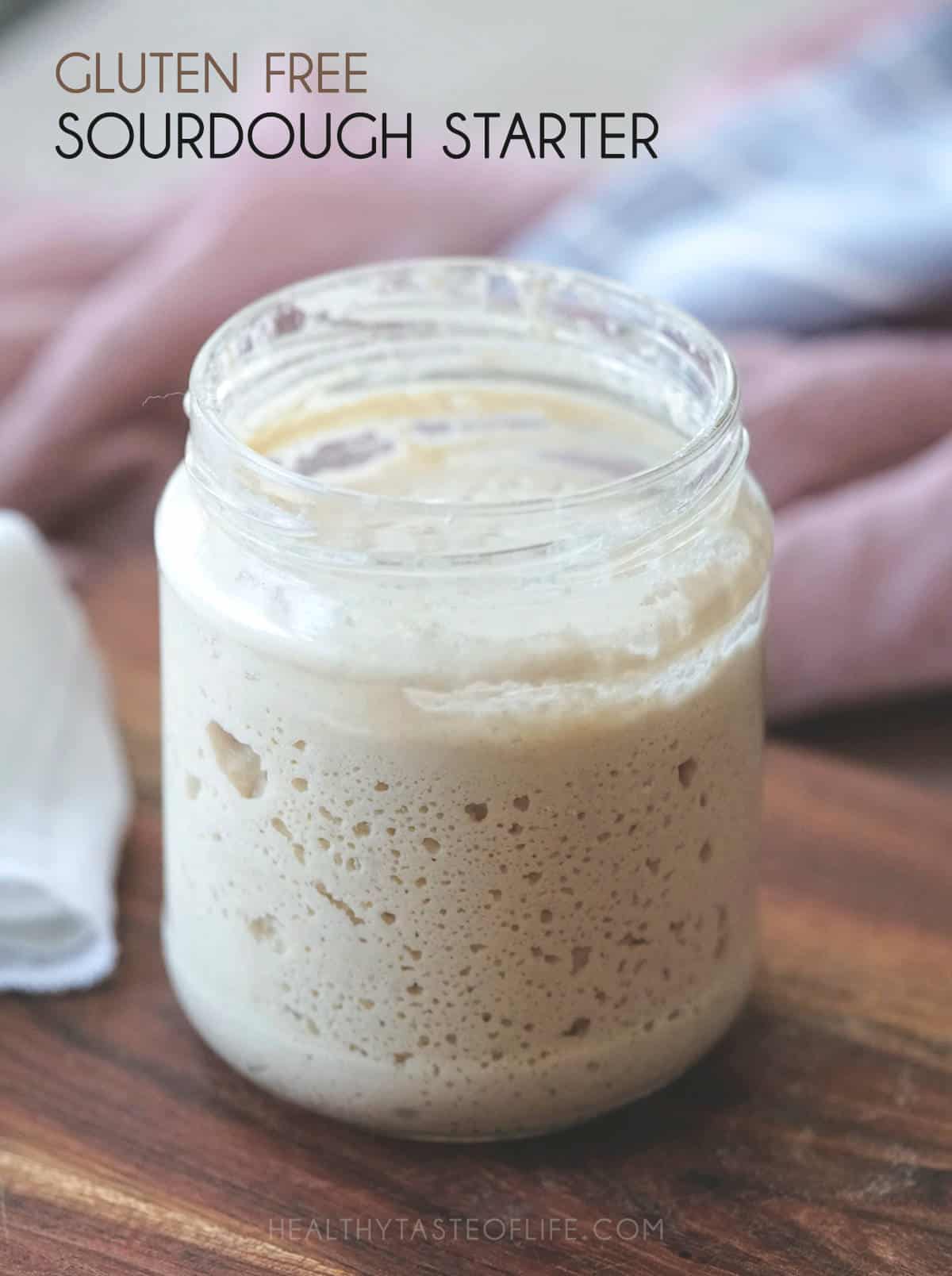
I never had a gluten free sourdough starter recipe on my website before because I knew there are so many online, and probably people didn’t want another one. But recently when I started the new gluten free sourdough starter, I realized no one actually uses the same method.
It works well and it bakes wonderful gluten free sourdough breads: my favorite is this Vegan Gluten Free Sourdough Bread if I want a white bread, or this Gluten Free Sourdough Pumpernickel Bread as a darker more aromatic sandwich bread. No to mention you can also make gluten free sourdough buns , some English muffins and even soft gluten free tortillas.
I also have included the recipe plus a few more gluten free sourdough bread recipes in my cookbook, if you want to check them out.
Ways to Make Gluten Free Sourdough Starter
If you decided to make your own gluten free sourdough starter, you have 3 options:
1. Make it from scratch with just whole grain gluten free flours and water.
2. Add a helper: fruits, cabbage leaves, water kefir or juice from homemade sauerkraut.
3. Or buy a starter culture that also acts like an aid and ensures that the whole process of making a gluten free sourdough starter is successful.
Gluten Free Sourdough Starter Culture
I created my first gluten free sourdough starter in 2016 and I used method number 3, because I didn’t want to fail and waist time and supplies. I managed to bake a lot of gluten free sourdough breads with it. I maintained it for 4 years until one day a pack of raw meat that was seating on the top shelf in the fridge, leaked its juices all the way down on my sourdough starter and I had to throw it away and start a new one.
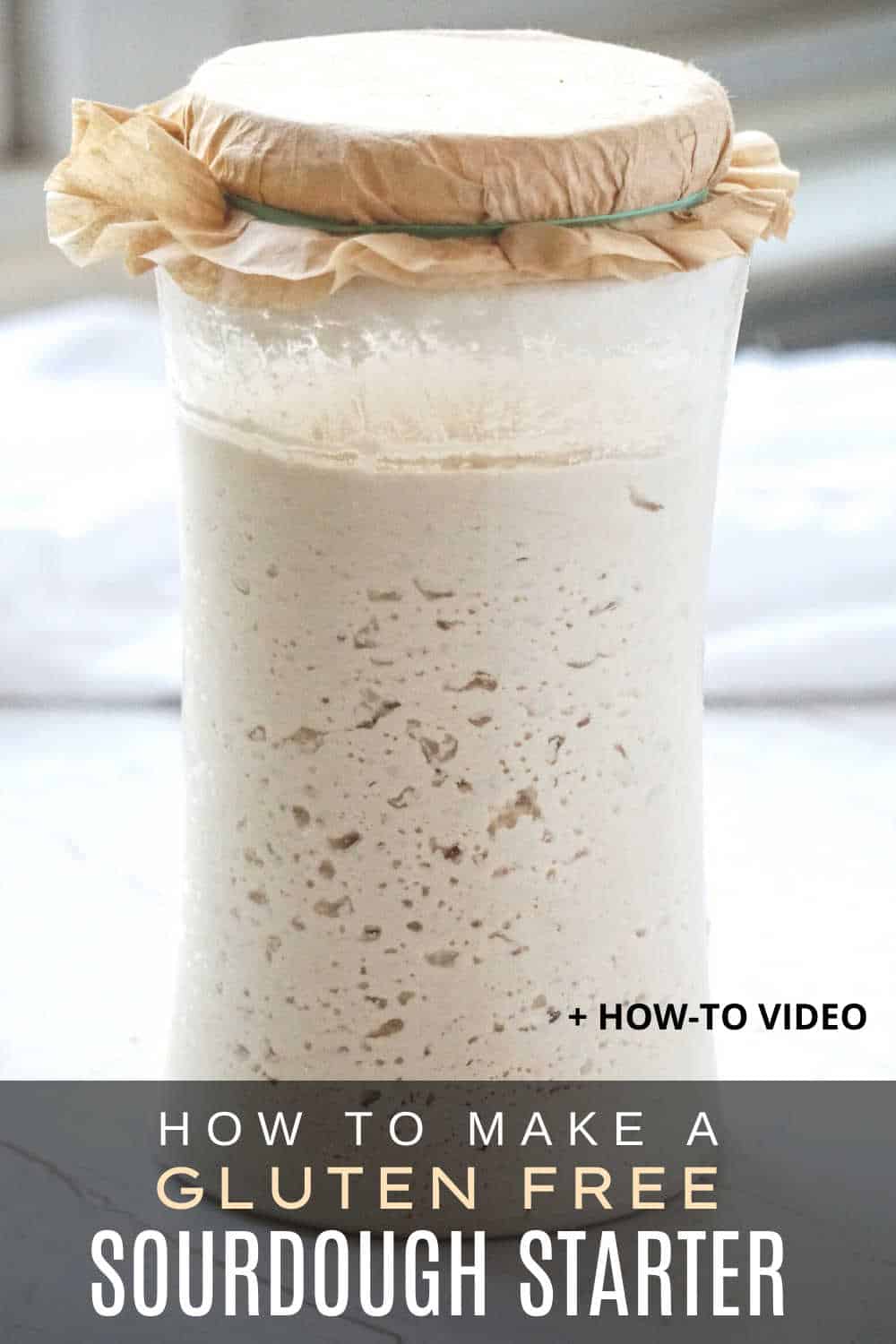
My Way Of Making Gluten Free Sourdough Starter
So here is how I do it. Just like the first time I used a gluten free sourdough starter culture from cultures for health (which is basically an established starter, packed in a dehydrated form, made from brown rice) all you have to do, is activate it with flour + water and it gives you the peace of mind that it won’t fail, because you know that this strain of starter has already been used to produce good bread.
How To Make A Gluten Free Sourdough Starter
The hardest part of making gluten free sourdough bread is waiting for the starter to mature. Then the process of maintaining it is a breeze, nothing complicated!
Equipment Needed
- A large bowl or jar – that will allow your starter to grow up to 3 or 4 times its volume. I used two 64 oz mason jars with lids (not hinged lids). One for the starter and one for accumulating the discard.
- A cloth and a rubber band to cover the jar – a cheese cloth or a pre-cut muslin cloth, that will allow the starter to “breathe”.
- Spatula for mixing and keeping the walls of the jar clean, but actually you can use anything.
- A kitchen towel to cover the jar while fermenting to protect the starter from too much light.
- Measuring cups for measuring the flour and water.
Activating The Gluten Free Sourdough Starter
The process of activating the gluten free sourdough starter can take from 5 to 10 days, it depends on a lot of factors. The package of sourdough culture comes with instructions on how to activate it, but the description doesn’t always coincides with what can happen in reality, so this is how it worked for me (also make sure to watch the video below, for visual presentation):
Day 1: In your jar combine 1 tablespoon of brown rice flour and 1 tablespoon of filtered warm water, and add the packet of sourdough culture, stir well to incorporate. You might need to add another 1 tsp of water, if it feels too thick to mix. Cover loosely with a cloth secured with a rubber band and let it sit at room temperature (75-80°F is ideal) for 24 hours. Cover the jar with a towel if your kitchen is really sunny during the day.
Day 2: Feed the starter with 2 more tablespoons of flour and 2 tablespoons of water, stir. The mixture should have the consistency of a pancake batter. Let it ferment for another 18-24 hours.
Day 3: After 24 hours, no bubbles yet (my kitchen was quite cold) but I fed it with another 4 tbsp of flour and 4 tbsp of water.
Day 4: After 18 hours I could see really tiny bubbles and feel a mildly acidic smell (it’s a sign the starter is hungry) and I fed it again with 1/2 cup flour + 1/2 cup water. As the starter is getting hungrier and growing I noticed that the time between feedings needs shrinking.
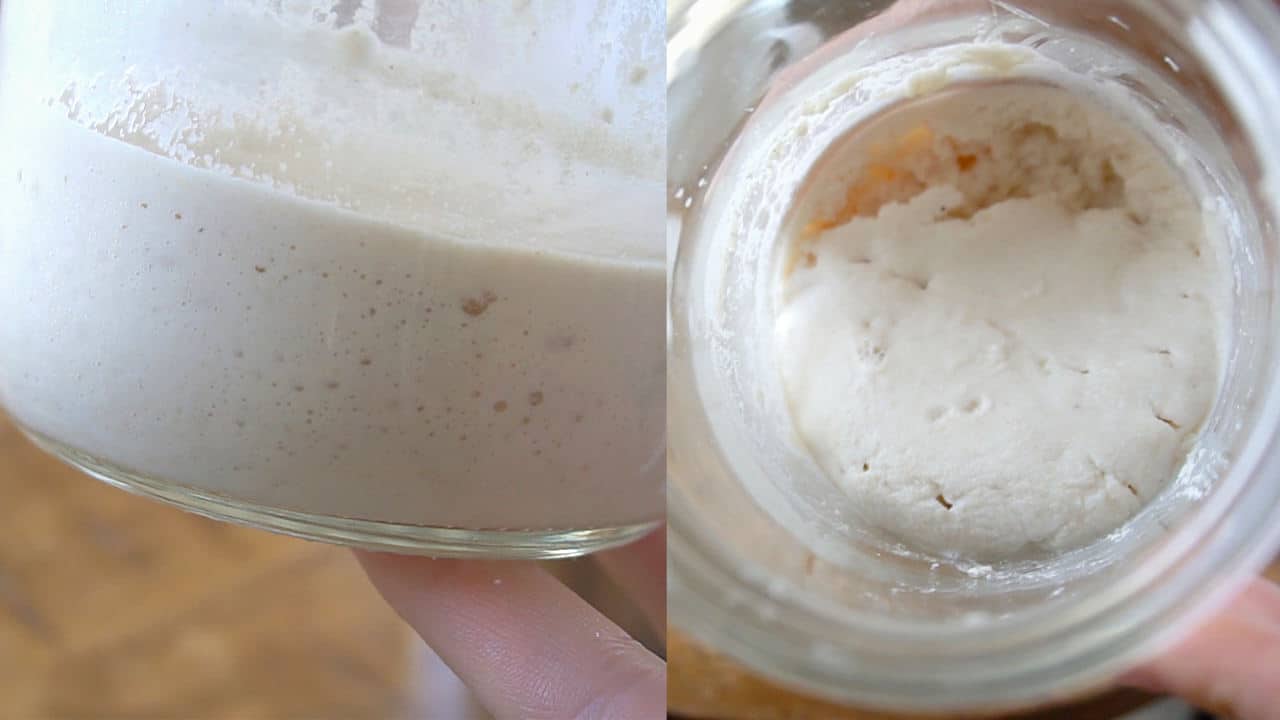
Day 5: This time after only 14 hours I could notice more bubbles and more activity (fermentation). I fed it again, this time with 1 cup of flour + 1 cup of water.
Day 6: After 12-14 hours, the starter developed more bubbles abut it also had some liquid accumulated on top plus a strong acidic smell. This usually means the starter is stressed and it needs more food and fed more often. I couldn’t wake up in the middle of the night to feed it, but it’s ok. In this situation discarding will revive the starter: first get rid of the liquid, and then discard (move to another jar) most of the starter and leave about 3-4 tablespoons. Feed it with 2 tablespoons of flour and 2 tablespoons of water.
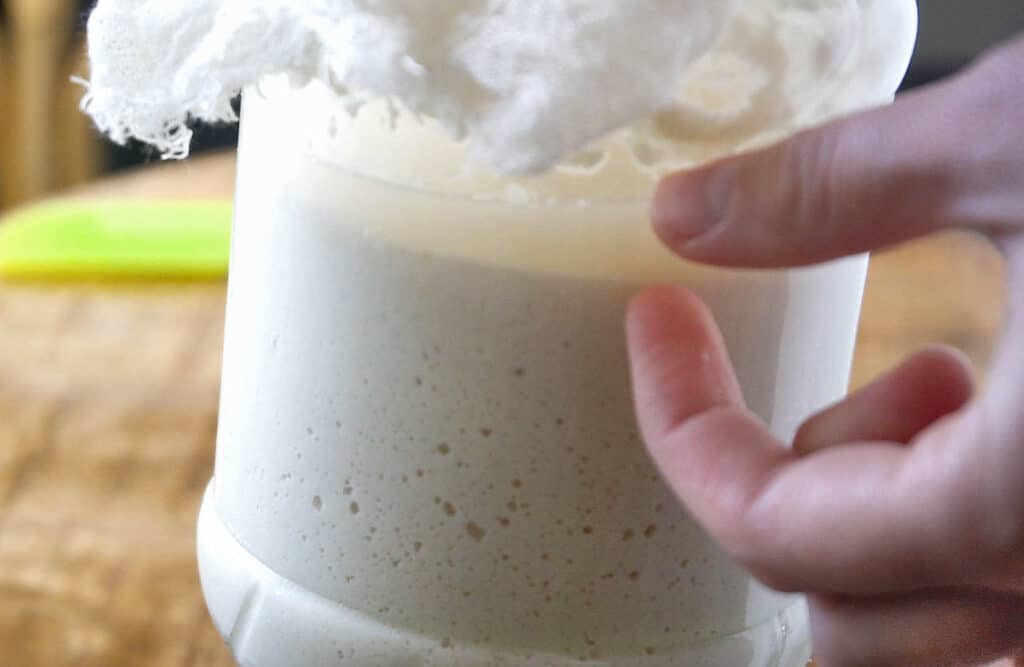
Day 7: Just like at the beginning after about 12-18 hours it started to develop small bubbles. I fed it again with equal amount of flour and water – 1/4 cup each. Same day after only 8 hours (at midnight) the starter was showing increased activity and I had to feed it again, this time with 1/2 cup flour and 1/2 cup of water. I placed it in a warm oven, turned off (not hot, it would kill it).

Day 8: In the morning (after 8 hours) the fermentation process was very active, bursting and bubbling like it was boiling. I discarded again half of it (about 1/2 cup) and fed it with 1 cup of water and 1 cup of flour. I increased the ratio of starter : flour : water (1/2 : 1 : 1) in order to grow faster.
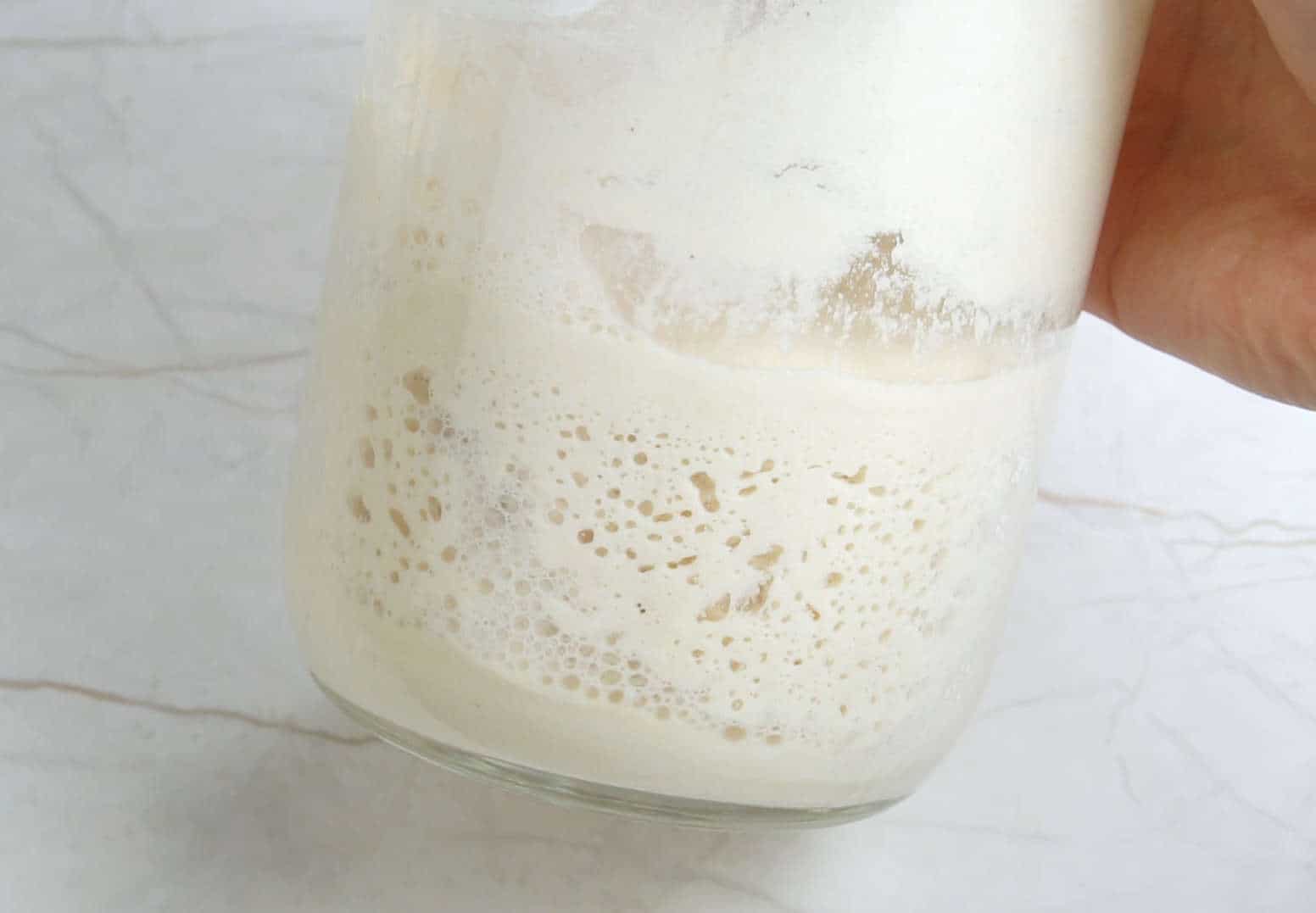
Day 9: After 8 hours: the next feeding was supposed to be during the night and I didn’t bother waking up, and by the morning it started to show signs of deflating again. Less activity, but still: a lot of bubbles and no sign of liquid on top. I discarded 1 cup of starter (aprox. 1.5 remained in the jar) and added 1.5 cup flour + 1.5 cup water (1:1:1). And placed it in a dark warm spot.
Same Day: After only 4-5 hours the starter doubled in size, it looked puffed up and very bubbly (see video). That’s how should look a “ready to bake” starter.
To summarize: the way to maintain a healthy and manageable starter: is to pour off (discard) some starter each time you feed it. And maintain this ratio: starter : flour : water (1 : 1 : 1).
Don’t worry so much about being exact. That was one of my biggest fears in beginning a sourdough starter. With time I wasn’t measuring anything anymore. I was just eyeballing so the amount are kept at equal ratios and the time between feedings: 12 to 24 hours not longer. And everything went perfectly fine from there.
How To Maintain A Gluten Free Sourdough Starter
I suppose there aren’t many of us who bake every day, so once the starter matures, is best to be kept in the refrigerator in order to slow down it’s activity.
Just make sure that before refrigerating, the starter is freshly fed. From here I usually feed it once a week before baking. I just take the necessary amount, bring it to room temperature and feed it with equal amount of water and flour. The rest which remains in the jar is fed as well, but it stays in the fridge.
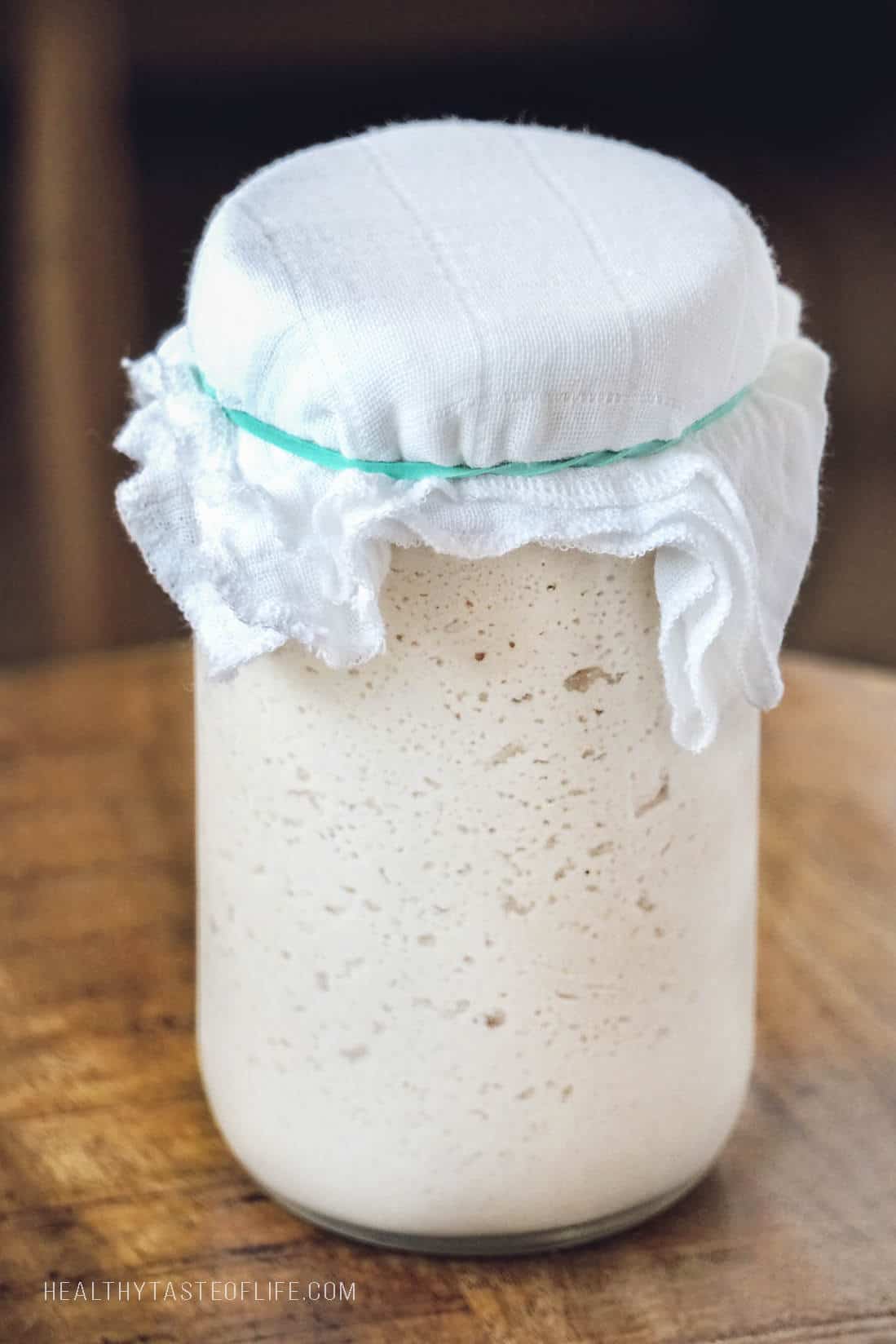
That’s how I maintained it for 4 years. Once, I left the country for a month and 10 days and I just forgot about it in the fridge. When I came back I thought it’s dead: it was dry, very smelly (acidic) and flat. I discarded most of it, except 1/4 cup. Then I added 1/2 cup of flour and 1/2 of water, left it at room temperature and in 8 hours it was bubbly and happy again. I couldn’t believe it!
How To Store The Starter
If you’re continuing to use and feed the starter, just keep it in its original jar. If you decide it is time to take a break for 3-4 days, transfer it to a sealable glass jar, mix the starter to a slightly stiffer consistency and keep it in a few degrees colder environment. The reduced hydration will slow fermentation activity. If you’re planning to bake once a week, store the gluten free sourdough starter in the refrigerator.
For long-term sourdough starter storage (2 week and longer) is best to dry it out in flour. Place a large dollop of your active sourdough starter in the bottom of a bowl. Cover it with lots of flour (the same flour used for feedings) and use your hands to pinch through the mixture, and break up the clumps. Continue doing this until the mixture feels completely dry. Add flour if necessary. Then let the bowl sit out exposed to dry air for a day. Then, place it in a jar and seal.
Gluten Free Sourdough Starter Troubleshooting
Can I Feed My Sourdough Starter Without Discarding?
Technically you could, just like you saw in the video I tried to discard less at the beginning and it ended up with slowing down the fermentation and the accumulation of a large amount of discard. So it better to feed smaller amounts and keep it minimal.
What Do You Do With Sourdough Starter When Discarded?
I don’t throw away my discard, I keep it in a separate jar in the fridge for use in other recipes. It can be used in gluten free sourdough pancakes, tortillas, waffle recipes, crackers (see my posts below). Every time I have to discard, I transfer it in the other jar. The buildup can be used immediately or during the week.
What Is The Difference Between Sourdough Discard And Starter?
The discard is just unfed starter. It can always be fed again later to make it active. Once a sourdough starter is established, there is no need to discard every time you feed it. Simply add flour and water to the jar, and stir.
Recipes Made With Sourdough Starter Discard
- Gluten Free Sourdough Pancakes (Gluten And Dairy Free)
- Gluten Free Sourdough English Muffins (Vegan)
- Soft Gluten Free Wraps / Tortillas (Vegan)
- Gluten Free Sourdough Crackers With Seeds (Vegan)
- Gluten Free Sourdough Eggless Banana Bread
What Type of Flour To Use
The best flour type to use is a wholegrain variety. Whether is brown rice flour, buckwheat, sorghum or teff it doesn’t matter, they are more nutritious than the refined varieties.
For consistent results, is best to avoid switching flours while you’re building the starter. Stick with the same flour you started so you don’t disrupt the process. With time you can switch to a combination of flours, and even move it to a 100% different flour feed.
What Water To Use For Sourdough Starter
I use filtered water, and I do recommend using filtered water if possible. The microorganisms from the sourdough starter can be affected by chemicals in the water. If you live in an area with heavily contaminated water than is best to use filtered or bottled water.
Gluten Free Sourdough Starter Feeding Schedule
I recommend feeding your starter every 18 hours for the first 2-3 days, to see how it behaves. If it stays the same with little activity than wait up to 24 hours before next feeding. If the starter develops bubbles quickly and rises up in the mason jar then reduce the time.
Beyond those 3 days if the starter bubbles becomes quite active, rises and falls well before each feeding, then you need to feed it more often (because the microorganism finish their food quickly). If is not falling before you feed it again, then you can extend the time between feedings. It all depends on the temperature in your kitchen, adjust the time accordingly.
Starter Feeding Ratios
My golden feeding ratio is: 1 part starter to 1 part flour and 1 part water (by volume). It easier, quicker and is working.
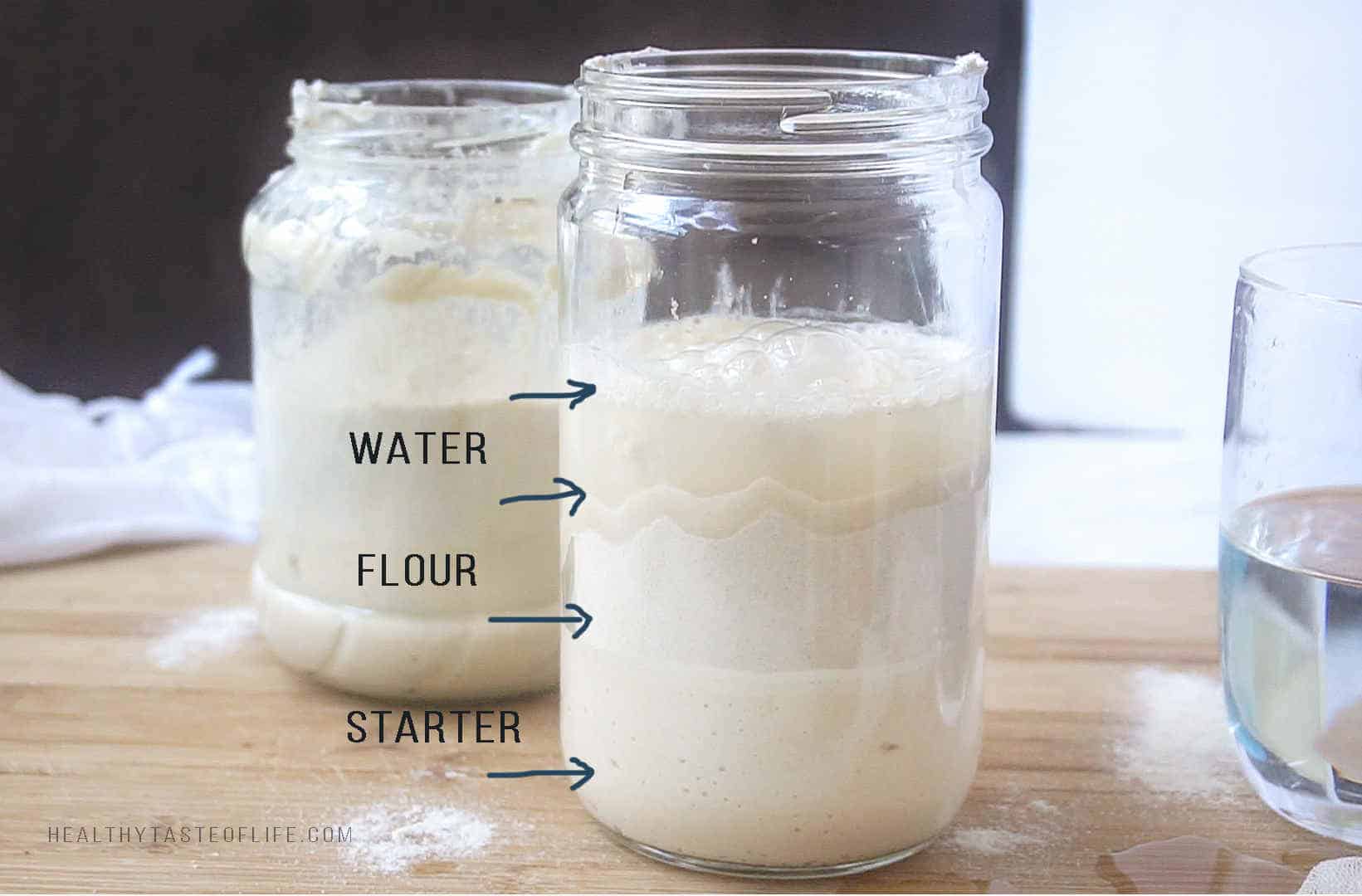
These amounts are a just a general guide. If your starter ever seems too dry or too wet, feel free to add a splash more water or flour until the desired consistency is reached. I usually keep it at the consistency of a pancake batter.
Kitchen Temperature
The ideal room temperature for you gluten free sourdough starter is 75-80°F (23-27°C).
If your house stays warm, building your sourdough starter will take less than 7 days. If you keep your house cooler, still works, it just may take 7 to 10 days, as I described my method above.
A good trick, I’m sure already many people know it, is to tuck the jar in a warm dark location like a turned off oven, with walls that are still warm from a previous bake. Check with your hand, it shouldn’t be hot, just barely warm.
Another option is to place a pot with steaming water inside and keep the door closed. The oven becomes a warm and moist environment for the yeast to to grow.
The Gluten Free Sourdough Starter Is Not Bubbling
If the gluten free sourdough starter is still not bubbling after 3-4 days of starting it, it means it needs more time and it needs some help to activate. This is the case if it smells nice and not acidic.
To encourage faster fermentation make sure the water you are using is slightly warm, around 85-90 F (29-32 C) and that after feeding you are keeping it in a warm spot.
Let your starter rise as high as it wants to, and don’t feed before it begins to fall.
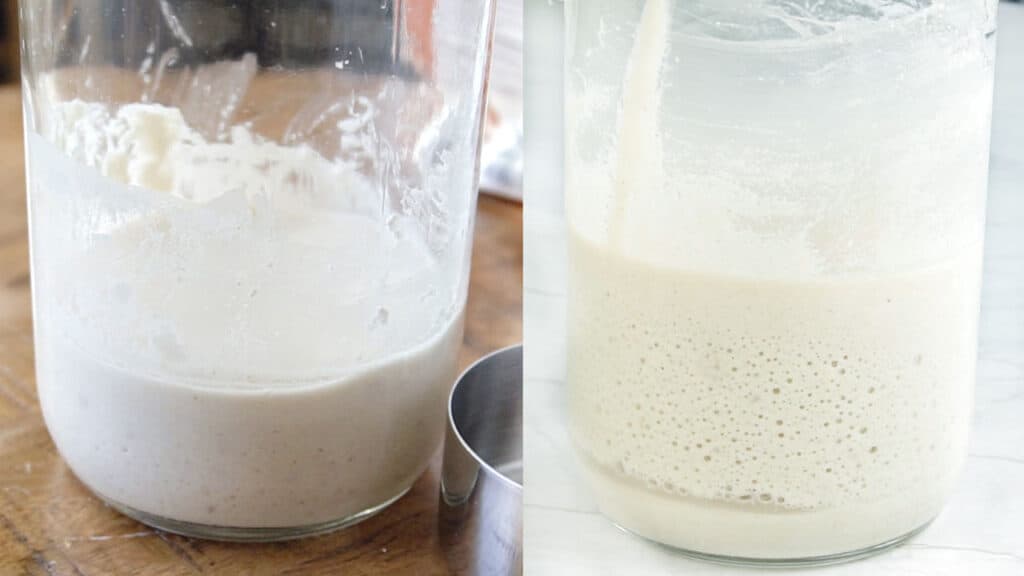
Also take into account that sourdough starters that are thin and runny may not show as many bubbles. But they are still active.
It Develops a Layer Of Liquid And Smells Acidic
This layer of liquid (called hooch) sometimes forms on top of the starter. This is an alcoholic by-produce of the yeast and can smell really acidic or like alcohol. This is a sign that is needing more food and getting too hungry faster thus becoming week.
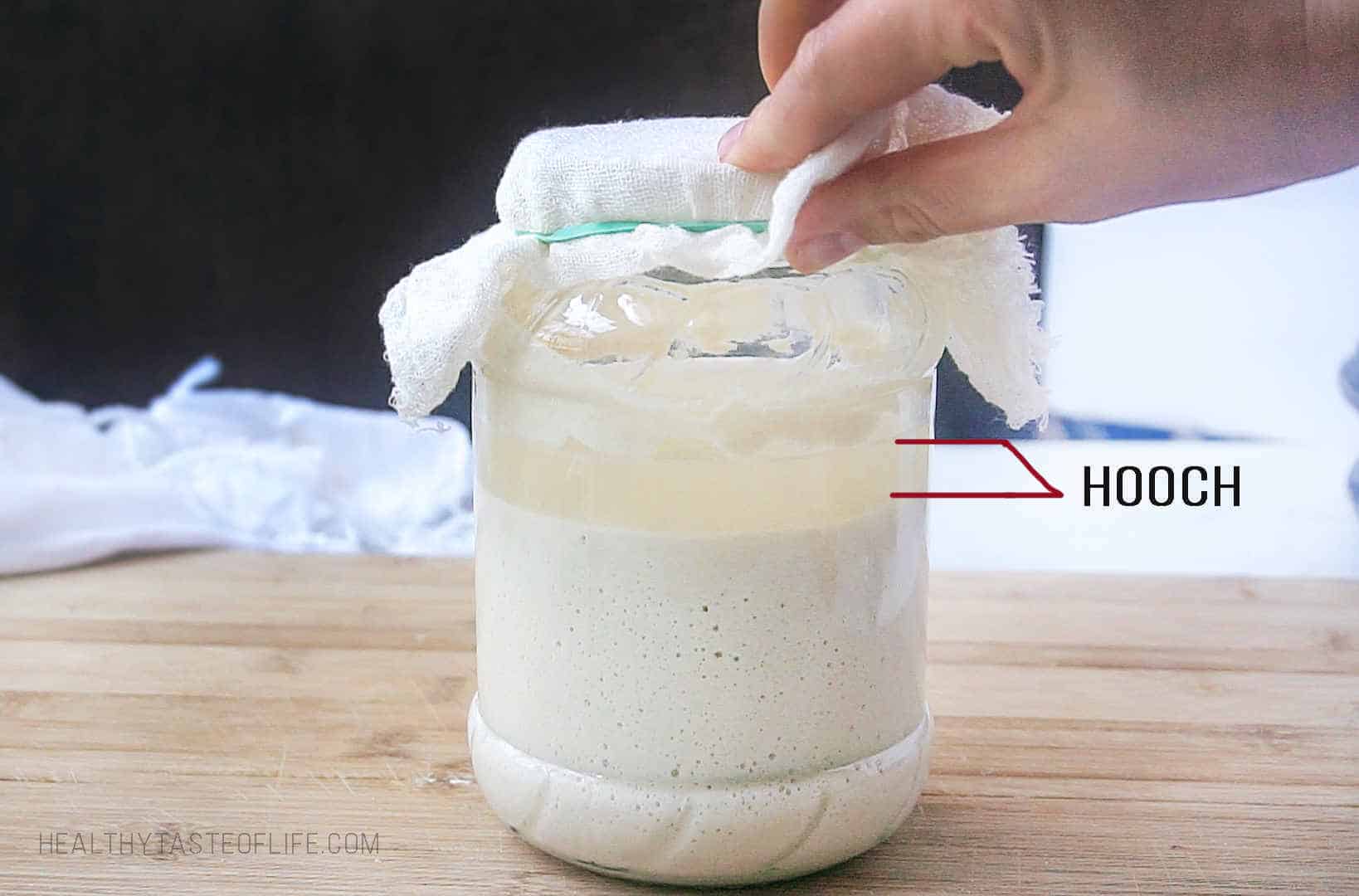
The problem: it’s not being fed enough and/or often enough.
Solve it: pour it off, then discard most of the starter and adjust your feeding schedule accordingly. If a second feeding doesn’t work as well, you can increase to a 1:2:2 feeding ratio.
Sluggish Gluten Freee Sourdough Starter
It started to get more bubbly but then it got lazy and shrank in size? To revive it, pour off (discard) all but about 1/2 cup of starter (you can eyeball it) and then feed it with equal amounts of flour and filtered water (1/2 cup each).
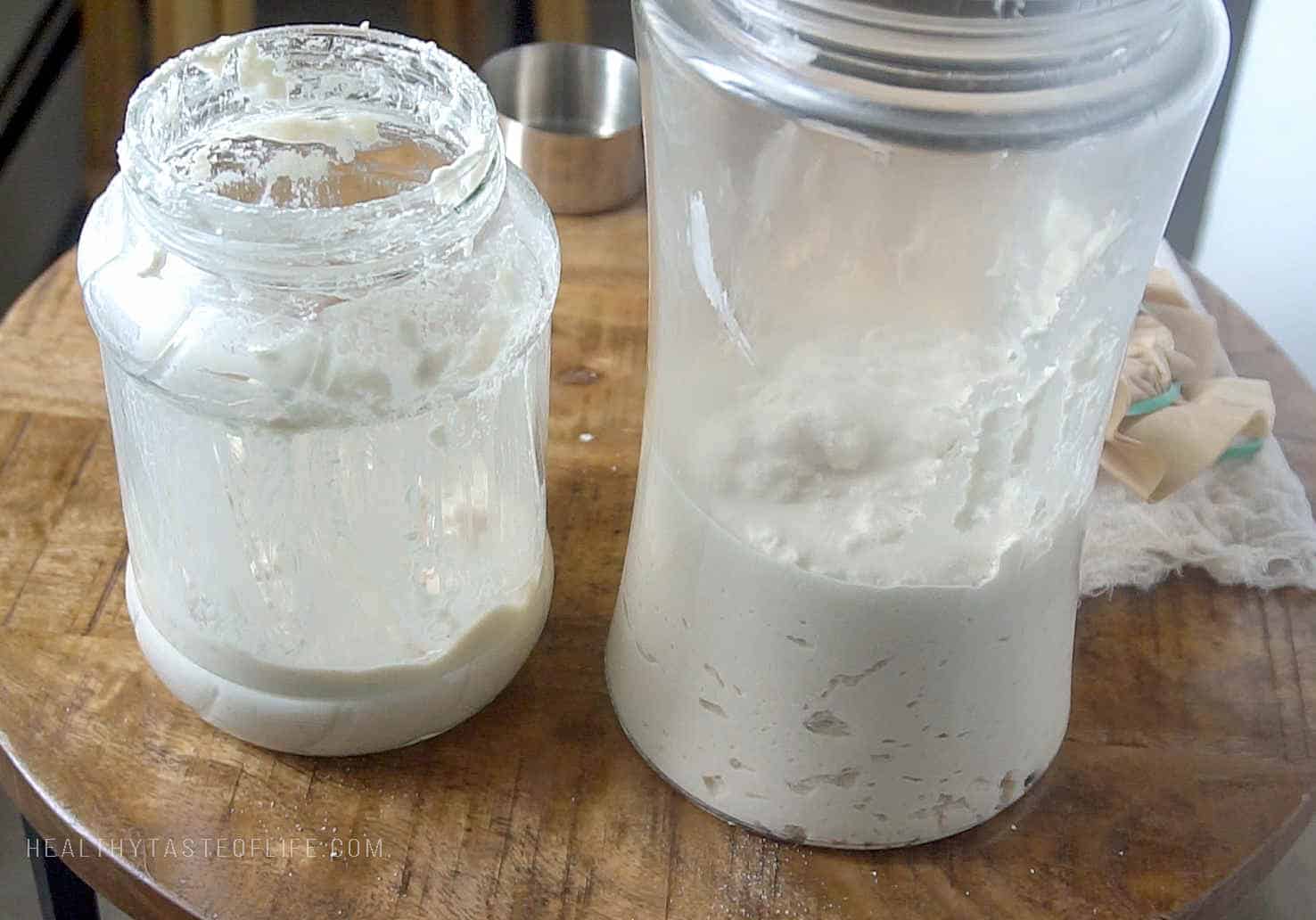
When The Starter Is Ready To Bake
Bubbles in your starter is a great sign, but if it isn’t strong enough to raise itself up, it definitely isn’t strong enough to leaven your bread. A “ready to bake” starter, at 100% hydration, should triple in 4-5 hours after feeding.

Mold In The Gluten Free Starter
There is nothing you could do here, throw it, start another batch.
Watch Video: How To Activate And Maintain The Gluten Free Sourdough Starter
Gluten Free Sourdough Starter (Build, Maintain, Troubleshooting)
Ingredients
- brown rice flour - organic (see blog post fore more info)
- filtered water - room temperature
- gluten free sourdough culture - you can use any brand, see notes below
Instructions
- Day 1: In a 2qt jar combine 1 tablespoon of brown rice flour and 1 tablespoon of filtered warm water, and add the packet of sourdough culture, stir well to incorporate. You might need to add another 1 tsp of water, if it feels too thick to mix. Cover loosely with a cloth secured with a rubber band and let it sit at room temperature (75-80°F is ideal) for 24 hours. Cover the jar with a towel if your kitchen is really sunny during the day.
- Day 2: Feed the starter with 2 more tablespoons of flour and 2 tablespoons of water, stir. The mixture should have the consistency of a pancake batter. Let it ferment for another 18-24 hours.
- Day 3: After 24 hours, no bubbles yet (my kitchen was quite cold) but I fed it with another 4 tbsp of flour and 4 tbsp of water.
- Day 4: After 18 hours I could see really tiny bubbles and feel a mildly acidic smell (it’s a sign the starter is hungry) and I fed it again with 1/2 cup flour + 1/2 cup water. As the starter is getting hungrier and growing I noticed that the time between feedings needs shrinking.
- Day 5: This time after only 14 hours I could notice more bubbles and more activity (fermentation). I fed it again, with 1 cup of flour + 1 cup of water.
- Day 6: After 12-14 hours, the starter developed more bubbles abut it also had some liquid accumulated on top plus a strong acidic smell. This usually means the starter is stressed and it needs more food and fed more often. I couldn’t wake up in the middle of the night to feed it, but it’s ok. In this situation discarding will revive the starter: first get rid of the liquid, and then discard (move to another jar) most of the starter and leave about 3-4 tablespoons. Feed it with 2 tablespoons of flour and 2 tablespoons of water.
- Day 7: Just like at the beginning after about 12-18 hours it started to develop small bubbles. I fed it again with equal amount of flour and water – 1/4 cup each. Same day after only 8 hours (at midnight) the starter was showing increased activity and I had to feed it again, this time with 1/2 cup flour and 1/2 cup of water. I placed it in a warm oven, turned off (not hot, it would kill it).
- Day 8: In the morning (after 8 hours) the fermentation process was very active, bursting and bubbling like it was boiling. I discarded again half of it (about 1/2 cup) and fed it with 1 cup of water and 1 cup of flour. I increased the ratio of starter : flour : water (1/2 : 1 : 1) in order to grow faster.
- Day 9: After 8 hours: the next feeding was supposed to be during the night and I didn’t bother waking up, and by the morning it started to show signs of deflating again. Less activity, but still: a lot of bubbles and no sign of liquid on top. I discarded 1 cup of starter (aprox. 1.5 remained in the jar) and added 1.5 cup of flour + 1.5 cup of water (1:1:1). And placed it in a dark warm spot.
- Same Day: After only 4-5 hours the starter doubled in size, it looked puffed up and very bubbly (see video). That’s how should look a “ready to bake” starter.
Video
Notes
Tips For Your Gluten Free Sourdough Starter
- The way to maintain a healthy starter: is to pour off (discard) some starter each time you feed it. Always maintain this ratio: starter : flour : water (1 : 1 : 1).
- The time between feedings: should be 12 to 24 hours not longer for the first 2-4 days and between 4 to 8 hours after.
- Gluten Free Sourdough Starter – used in the video can be purchased here, but you can use any other available brand like this one.
How To Store The Starter
- If you’re continuing to use and feed the starter daily, just keep it in its original jar. If you decide it is time to take a break for 3-4 days, transfer it to a sealable jar, mix the starter to a slightly stiffer consistency and keep it in a few degrees colder environment. The reduced hydration will slow fermentation activity.
- If you’re planning to bake once a week, store in the refrigerator. Feed it (once or twice, it depends how quickly it gets active) the day before you will bake (or at least 5 hours in advance).
- For long-term sourdough starter storage (2 week and longer), see blog post.
Don’t Throw The Discarded Sourdough Starter
Each time you discard (you will need to do that quite often) gather in a separate jar and keep it the fridge up to 2-3 weeks. Use it in recipes like pancakes, tortillas, crackers, English muffins etc.Nutrition
The information shown is an estimate provided by an online nutrition calculator.

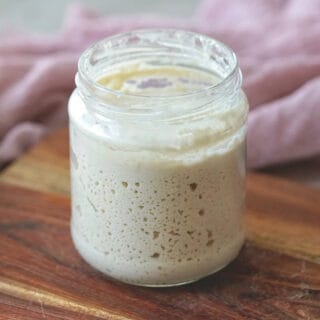
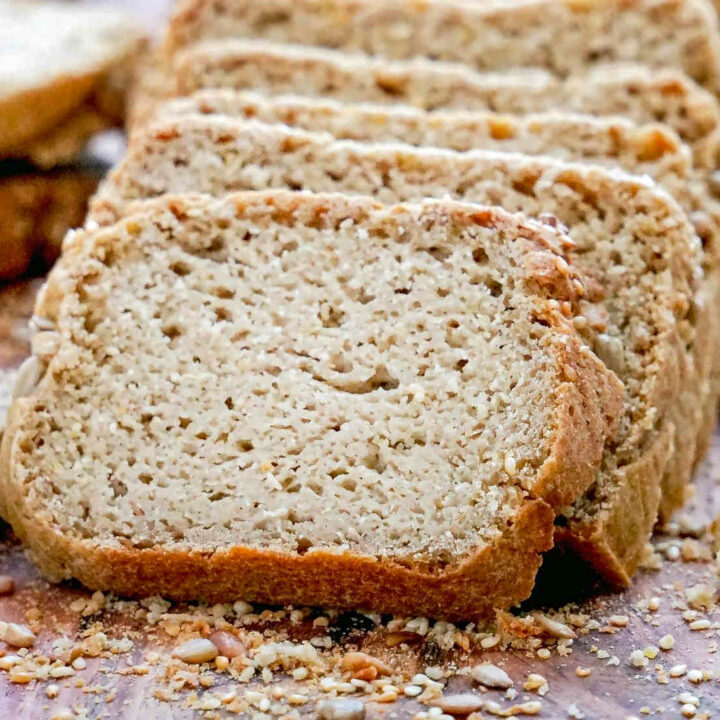
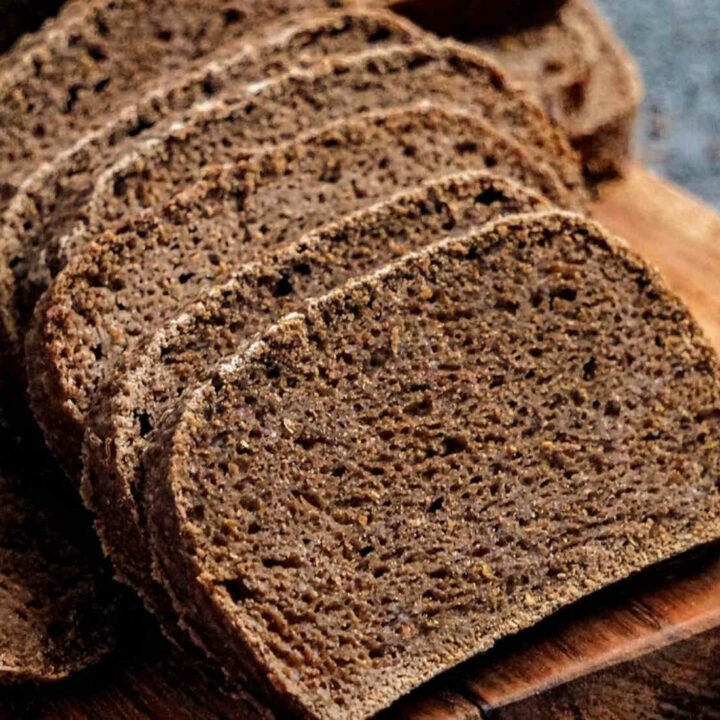
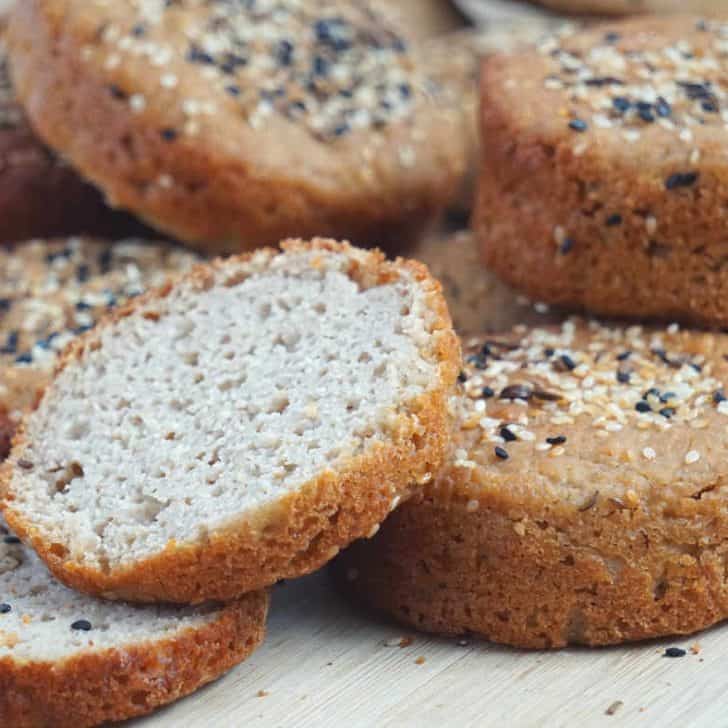
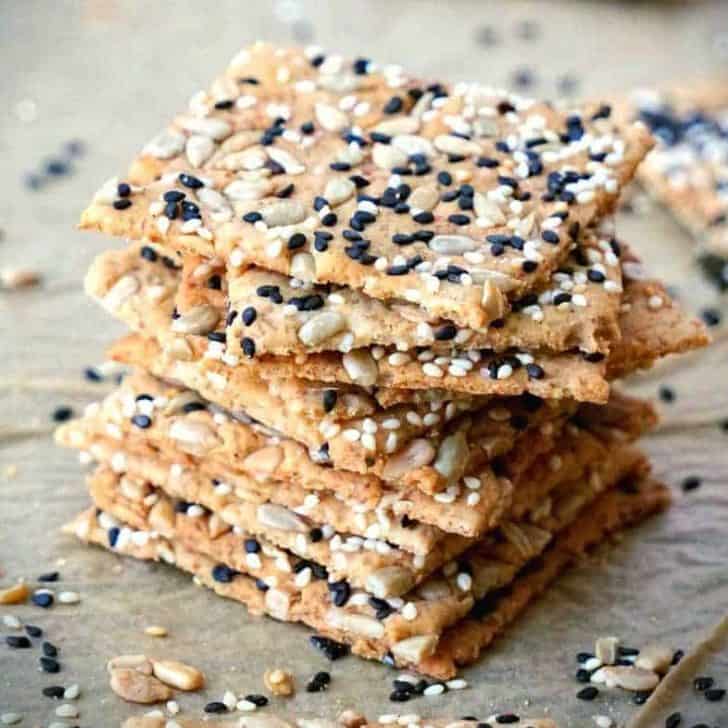
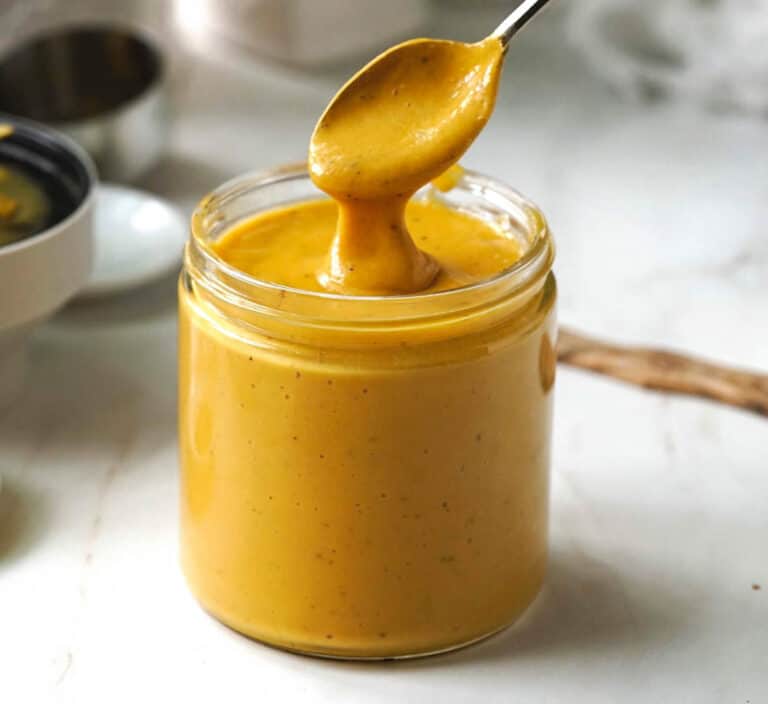
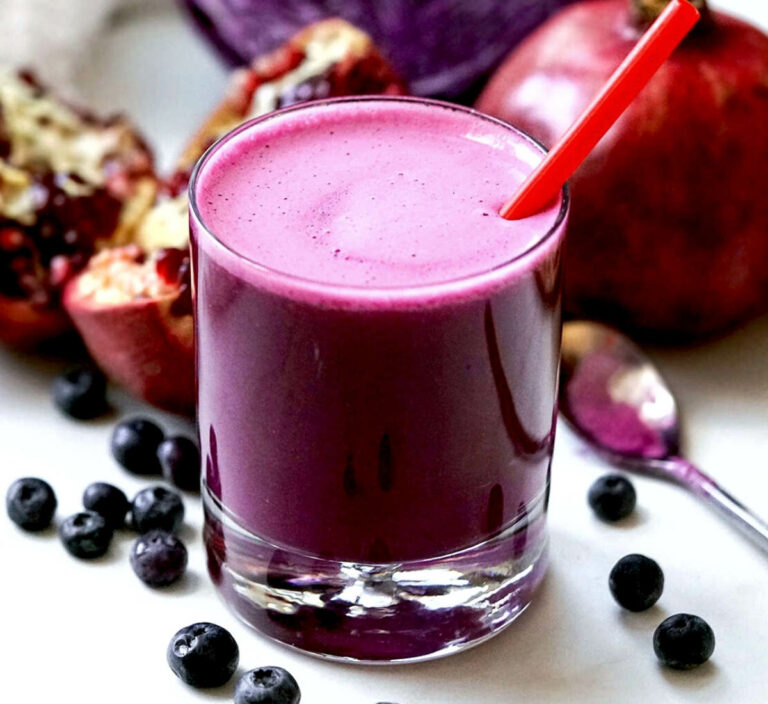
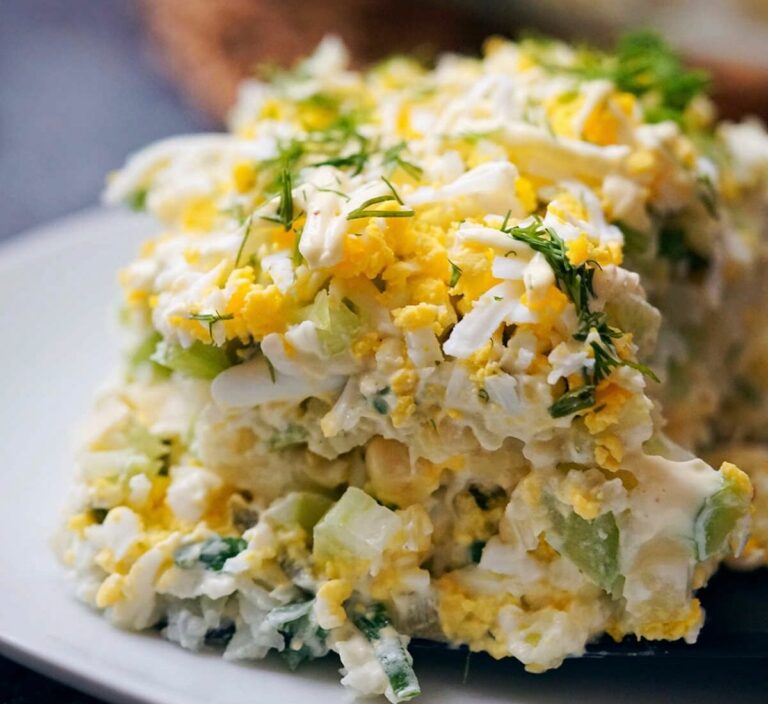

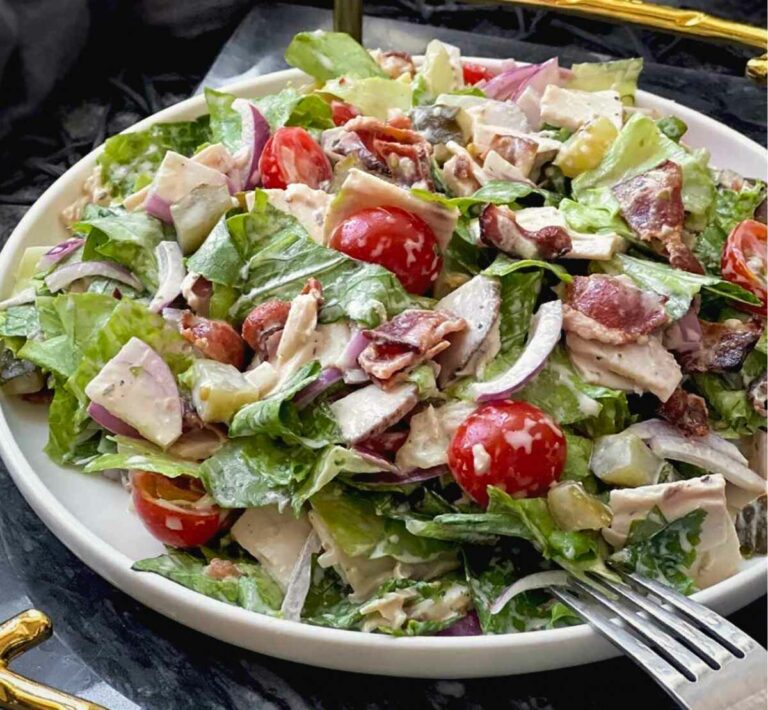
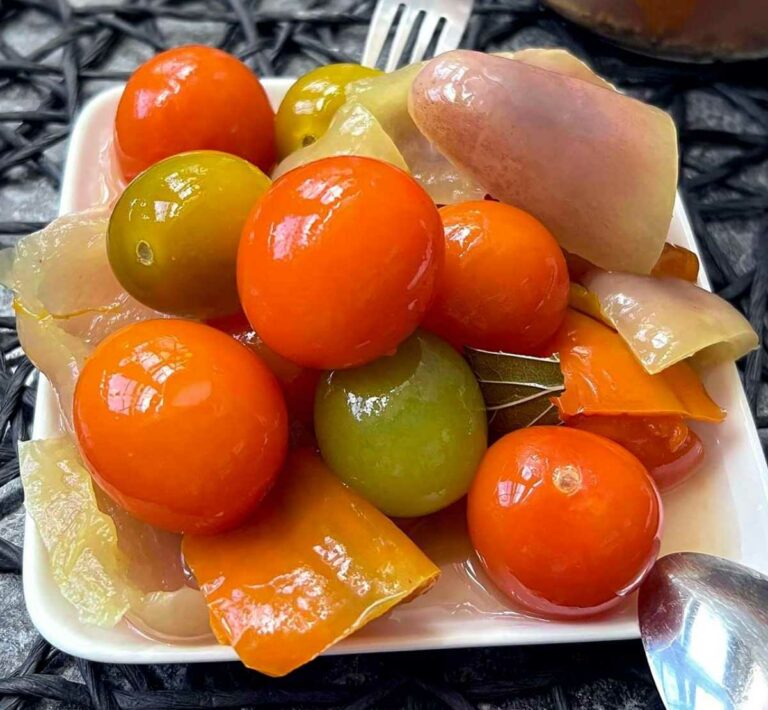
I have a question. I used the “Bob’s Red Mill Gluten Free 1 to 1 Baking flour” to creat a sourdough starter. The starter is rising quite quickly within a day but the texture is almost like squishy wet play dough or kinetic sand….any thoughts on what I’ve done wrong?
I never worked with this flour, so I can’t say anything about this experience.
Hi Olga. My name is Matt from Toronto. I’ve been reading your articles and just ordered all the bits for trying the GF starter and sourdough. Thanks so much for making such a wonderful website!
Hi Matt,I hope you succeed in your trial!
Thank you!
I’ve read that some people feed their regular wheat starter in a 1:2:2 ratio, as this makes it more active. Just wondering if this could be the case for gluten free starter too? Or 1:1:1 is sufficient and there is no need to do 1:2:2 ?
I found it to be sufficient when my starter is healthy. But you can change the ration if you notice the starter is getting weaker or if you want a fast revival.
Any chance you can provide a new link to the sourdough culture? It’s no longer available. Thank you!
Thanks for letting me know Peggy, it looks like they removed their product from Amazon. I included the link from other similar brand or you can find the link (in recipe notes) to their product on their website.
Thank you for clarifying the all possible situations that could arise with an uncooperative sourdough starter! It really helped me figure out the problem with mine.
I’m glad I could help! 🙂